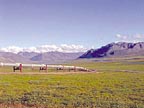
Exploration and development are surging, and state and industry leaders are confidently promoting plans for a project that would dwarf all current Alaskan undertakings: a $10 billion pipeline to carry natural gas in Alaska's north to the lower 48 states, an undertaking that could spark a boom akin to the one following construction of the oil pipeline.
Experts say that every day, oil producers on Alaska's North Slope bring up about 8 million cubic feet of natural gas as a byproduct of oil production, and every day they re-inject the gas back into the earth.
There are currently no buyers for this natural gas, and there are no pipelines or other means in place to ship the gas to market. Chuck Logsdon, chief petroleum economist for the state of Alaska, says, "Clearly there's lots of stranded gas in the Arctic, both in Alaska and in Canada. We've got lots of it, and it's not going anywhere right now."
The Alaska Department of Natural Resources reports that natural gas reserves in the North Slope total at least 31 trillion cubic feet. More than two-thirds of that is in the Prudhoe Bay field. Oil companies have been pumping oil in Prudhoe Bay since 1977. It is the nation's largest known but untapped gas reserve, and political and industry officials have long argued for a pipeline project to deliver North Slope gas to markets.
Local support for the gas pipeline is especially robust, though energy industry executives and Alaskan and Canadian leaders are feuding over just where such a pipeline should run.
Democratic Gov. Tony Knowles and other Alaska officials strongly favor a plan to build a gas pipeline that would run alongside the existing oil pipeline for much of its way.
But Canadians and many industry officials back a route that would go under the Arctic Ocean - just beyond the wildlife refuge - east to Canada, where the gas would flow south through existing pipelines.
The mention of these proposals alarm environmentalists groups, some of whose leaders worry aloud that the intense battle over the wildlife refuge has obscured other battles they say they should be fighting against energy development.
The individual oil-drilling projects still are small in relation to the reserves that could be found in the Arctic refuge. The projects now under way generally are measured in the tens or hundreds of millions of gallons, while federal geologists estimate that between 3 billion and 16 billion barrels of oil lie beneath the tundra at the refuge.
But in total, these smaller projects could well approach the size of the Arctic reserves, and there is strong pro-drilling pressure in the state, where oil money finances nearly all the state budget, with enough left over to provide every resident in Alaska with an annual "oil dividend" check that last year reached $1,963.86, an all-time high.
Moreover, while Congress can decide what happens in the refuge - and with the change of power in the Senate to Democratic leadership, the White House proposal to open the refuge to drilling is unlikely to go anywhere - many decisions about what happens here are in the hands of state officials, who strongly support oil and gas development.
Report Abusive Comment